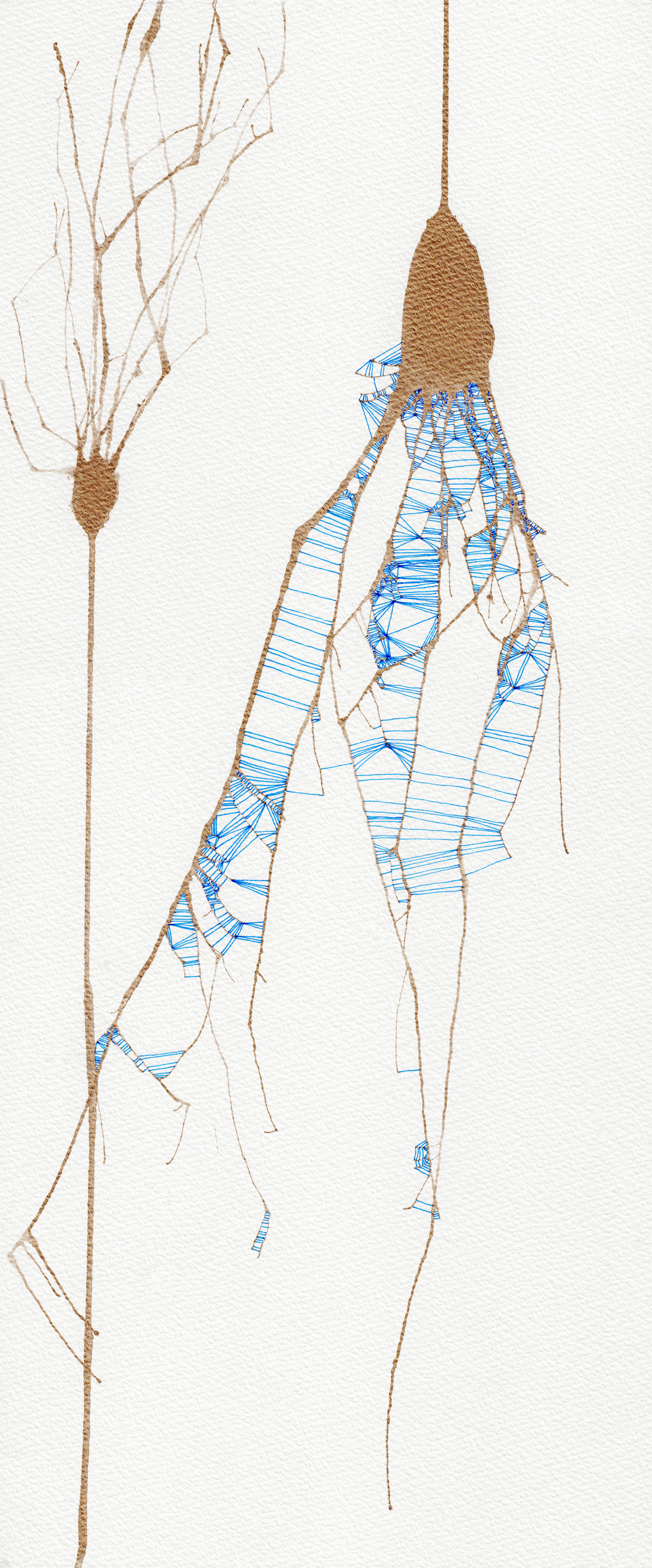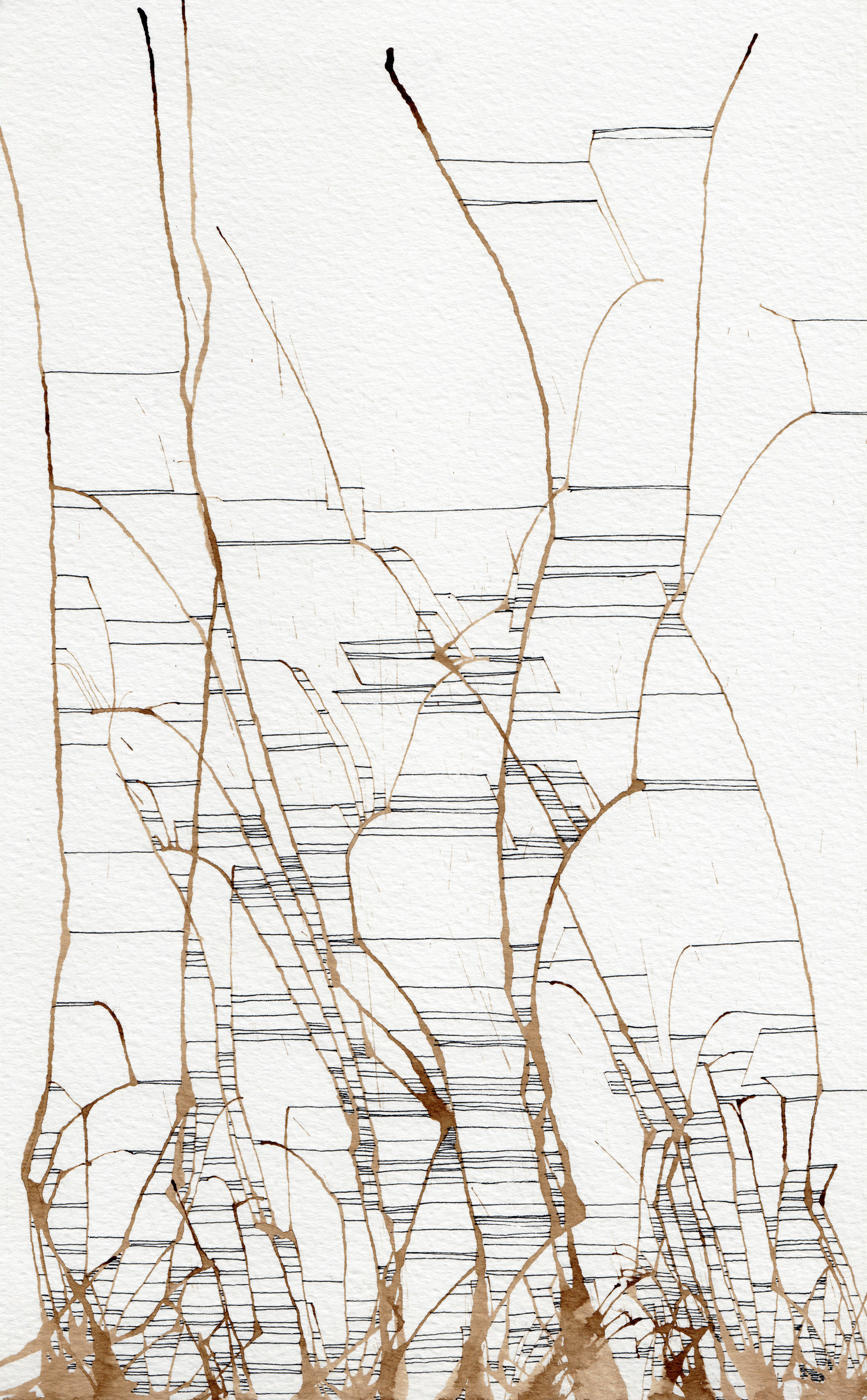Drawing, Screenprinting
2013
The explosion of generative computer artwork has fundamentally changed our visual landscape, but the lack of a human craft element has left the majority of these artworks cold and unapproachable. This series flips the computer algorithmic approach by using a human as the executioner of the algorithms.
As algorithms are the engines that drive natural and physical processes, these crafted algorithms provide a key to tap into an innate natural aesthetic that isn't possible by simply drawing pictures of things in nature which are merely the final product of an uncountable amount of natural code.
DRAWINGS



SCREEN PRINTS ("NONDRIAN")










ALGORITHM DEFINITIONS
CB: CHAMPAGNE BUBBLES
Linear rows of dots radiate perpendicularly from points on a shape’s edge. The length of the dot row is directly proportional to the amount that the point it is drawn from protrudes from the edge. Dot rows end when they collide with another shape’s edge.
CNDS1: CIRCLE NESTING DECREASING SIZE 1
In a given negative space between shape edges, the largest possible circle is drawn so that as much of the circle’s edge as possible touches the shape edges. The process is repeated fitting circles into negative spaces and between existing circles until the negative space is filled and the width of the pen is larger than the circle diameter.
In a given negative space between shape edges, the largest possible circle is drawn so that as much of the circle’s edge as possible touches the shape edges. The process is repeated fitting circles into negative spaces and between existing circles until the negative space is filled and the width of the pen is larger than the circle diameter.
CNDS2: CIRCLE NESTING DECREASING SIZE 2
Same as CN1, but circles are only nested within negative spaces that are decided to be part of a specific composition.
Same as CN1, but circles are only nested within negative spaces that are decided to be part of a specific composition.
CNIS: CIRCLE NESTING INCREASING SIZE
In a given negative space between shape edges, circles are used to fill in sharp angles in the shape edges. Starting from the smallest possible circle in the deepest corner of the angle, larger and larger circles are added to continue reducing the radius of the overall angle and subsequently filling in the space between the edges.
In a given negative space between shape edges, circles are used to fill in sharp angles in the shape edges. Starting from the smallest possible circle in the deepest corner of the angle, larger and larger circles are added to continue reducing the radius of the overall angle and subsequently filling in the space between the edges.
CNISE: CIRCLE NESTING INCREASING SIZE EDGE
Circles of increasing diameter are nested along the edges of a given ink drawing. The nesting area is determined by the level of imperfection of the edges of the drawing: the more imperfect, the larger the circle.
Circles of increasing diameter are nested along the edges of a given ink drawing. The nesting area is determined by the level of imperfection of the edges of the drawing: the more imperfect, the larger the circle.
CNWS: CIRCLE NESTING WITHIN SHAPES
Within a given shape (usually a narrow blown line) the largest possible circle is drawn so that as much of the circle’s edge as possible touches the shape edges without going beyond them. The process is repeated fitting circles into shapes and between existing circles until the shape is filled and the width of the pen is larger than the circle diameter. A white highlight spot can also be added to each circle.
Within a given shape (usually a narrow blown line) the largest possible circle is drawn so that as much of the circle’s edge as possible touches the shape edges without going beyond them. The process is repeated fitting circles into shapes and between existing circles until the shape is filled and the width of the pen is larger than the circle diameter. A white highlight spot can also be added to each circle.
CNWS+EBC1: CIRCLE NESTING WITHIN SHAPES + EDGE BUMP CONNECTOR 1
After following the CNWS algorithm, the EBC algorithm is run using the drawn circles as the bumps to be connected.
After following the CNWS algorithm, the EBC algorithm is run using the drawn circles as the bumps to be connected.
EEBC1: EXTERNAL EDGE BUMP CONNECTOR 1
Like EC1, but the only parts of edges that are connected with lines are bumps in the edge’s surface. Lines can cross over each other.
Like EC1, but the only parts of edges that are connected with lines are bumps in the edge’s surface. Lines can cross over each other.
EEBC2: EXTERNAL EDGE BUMP CONNECTOR 2
Same as EBC1, but first the bumps on the edges are called out with a drawn dot. The end of each blown ink line can also be called out with the same type of dot.
Same as EBC1, but first the bumps on the edges are called out with a drawn dot. The end of each blown ink line can also be called out with the same type of dot.
EEC1: EXTERNAL EDGE CONNECTOR 1
Two edges of one or more shapes are connected with a solid straight line. The line should always be drawn between the 2 closest points on the edges first, then should move to the 2nd, 3rd, etc closest points. No lines can ever cross each other.
Two edges of one or more shapes are connected with a solid straight line. The line should always be drawn between the 2 closest points on the edges first, then should move to the 2nd, 3rd, etc closest points. No lines can ever cross each other.
EEC2: EXTERNAL EDGE CONNECTOR 2
Same as EC1, but using dotted lines instead of solid lines. Dotted lines that are determined to be more important to the composition can be converted into solid lines.
Same as EC1, but using dotted lines instead of solid lines. Dotted lines that are determined to be more important to the composition can be converted into solid lines.
EEC3: EXTERNAL EDGE CONNECTOR 3
Same as EC1, but every connection that is drawn is drawn with a pair of two parallel lines 1mm apart.
Same as EC1, but every connection that is drawn is drawn with a pair of two parallel lines 1mm apart.
EECH: EXTERNAL EDGE CONNECTOR HORIZONTAL
Same as EC1, but using dotted lines instead of solid lines. Dotted lines that are determined to be more important to the composition can be converted into solid lines.
Same as EC1, but using dotted lines instead of solid lines. Dotted lines that are determined to be more important to the composition can be converted into solid lines.
ER: EDGE ROUGHENING
A selected negative space between shape edges is outlined with a single line. It is then outlined again on the inside of the last outline, but the bumps in the shape’s edges are enhanced with each line that is drawn.
A selected negative space between shape edges is outlined with a single line. It is then outlined again on the inside of the last outline, but the bumps in the shape’s edges are enhanced with each line that is drawn.
ES: EDGE SMOOTHING
A selected negative space between shape edges is outlined with a single line. It is then outlined again on the inside of the last outline, but the radius of every angle between shape edges is decreased slightly. This is repeated until all radii are large enough that the negative space shape is smooth. If there is a significant pinch in the negative space, a single perpendicular line is drawn between the two closest points of the two edges and the algorithm is also applied to that line. Small negative space pieces that are the byproduct of increasing radii can be kept and smoothed out themselves.
A selected negative space between shape edges is outlined with a single line. It is then outlined again on the inside of the last outline, but the radius of every angle between shape edges is decreased slightly. This is repeated until all radii are large enough that the negative space shape is smooth. If there is a significant pinch in the negative space, a single perpendicular line is drawn between the two closest points of the two edges and the algorithm is also applied to that line. Small negative space pieces that are the byproduct of increasing radii can be kept and smoothed out themselves.
IEC: INTERNAL EDGE CONNECTOR
Two edges of a single shape are connected a solid internal line that connects the 2 closest internal points with the shape. This is repeated throughout the shape, and the outer edge of the shape is finally outlined again with straight lines connecting the ends of the internal lines. No lines can ever cross each other.
Two edges of a single shape are connected a solid internal line that connects the 2 closest internal points with the shape. This is repeated throughout the shape, and the outer edge of the shape is finally outlined again with straight lines connecting the ends of the internal lines. No lines can ever cross each other.
OE-S: OFFSET EDGE – SMOOTH
Edges are first outlined in as much detail as possible with a single line. Another line is then drawn that is offset from the last line – in the smooth version this next line slightly reduces the inconsistencies in the last line. The default is that the offset distance is the same as the line’s width. A greater offset can also be used and can be defined by the factor of multiplication of the line’s width.
Edges are first outlined in as much detail as possible with a single line. Another line is then drawn that is offset from the last line – in the smooth version this next line slightly reduces the inconsistencies in the last line. The default is that the offset distance is the same as the line’s width. A greater offset can also be used and can be defined by the factor of multiplication of the line’s width.
OE-R: OFFSET EDGE – ROUGHEN
Edges are first outlined in as much detail as possible with a single line. Another line is then drawn that is offset from the last line – in the roughen version this next line slightly exaggerates the inconsistencies in the last line. The default is that the offset distance is the same as the line’s width. A greater offset can also be used and can be defined by the factor of multiplication of the line’s width.
Edges are first outlined in as much detail as possible with a single line. Another line is then drawn that is offset from the last line – in the roughen version this next line slightly exaggerates the inconsistencies in the last line. The default is that the offset distance is the same as the line’s width. A greater offset can also be used and can be defined by the factor of multiplication of the line’s width.

